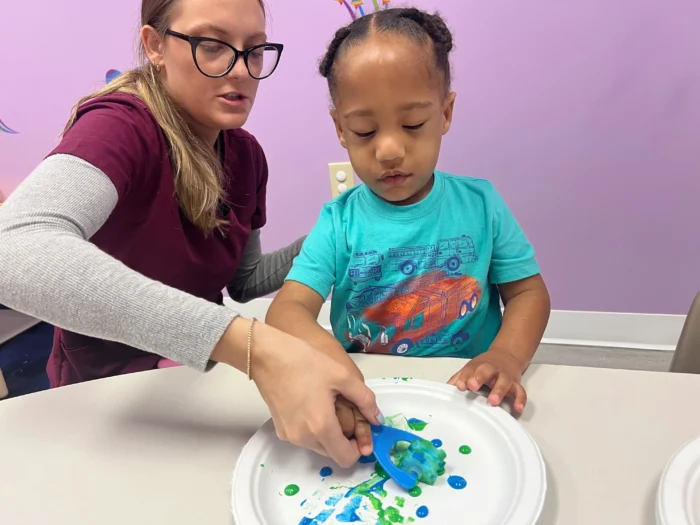
Autism, a complex neurodevelopmental disorder, has long been a subject of intense research and discussion, and questions about which parent’s genetics has the biggest impact.
In this article, we delve deep into the genetic aspects of autism, shedding light on the intricate dance of genes and their potential influence on the spectrum. By understanding the genetic underpinnings, you’ll be able to better comprehend the broader picture of autism and its manifestation in families.
Which Parent Carries Autism Gene, Mother or Father?
Both mothers and fathers can carry genes linked to autism. Therefore, as both parents contribute genetic material, either can pass on genes associated with an increased risk of developing autism.
On the other hand, if we’re talking about the probability of the genetic mutation coming from a mother or father, recent studies suggest that the autism paternal gene, i.e. certain genetic mutations from the father, might be more frequently passed on as siblings with autism share more of the paternal genomes.
Closer Look at Autism & Associated Genes
Autism Spectrum Disorder (ASD) is not the result of a singular genetic anomaly. Rather, a multitude of genes can elevate the risk of an individual falling on the spectrum. Notable genes such as SHANK3, ADNP, and CHD8 have been identified. Additionally, other gene mutations, like the MTHFR gene mutation, have been associated with autism, particularly when found in the maternal genome.
The question often arises: is autism a gene mutation? Indeed, mutations in certain genes can alter brain development in ways consistent with autism symptoms and autism heritability is a factor in about 40%-80% of the cases.
Paternal Genetic Factors
The age of the father at conception has been a point of interest in autism research. Older fathers tend to have a higher chance of sperm with genetic mutations, including those linked to autism. According to research, fathers who are over 50 years old have a 66% higher chance of having a child on the autism spectrum compared to fathers younger than 30.
Maternal Genetic Contribution
Mothers, too, can carry and pass on genes associated with autism. For instance, the MTHFR gene mutation and autism are connected, especially when this mutation is present in the maternal genome. It’s crucial to recognize that both parents contribute to the genetic makeup of their child, and either can pass on risk-associated genes.
Genetics Interacting with Environment
The question of “Is autism genetic or environmental” remains a topic of research. While genetics play a significant role, environmental factors during prenatal development, like exposure to certain toxins or infections, can influence autism’s onset. It’s this intricate dance between genetic markers, like a particular gene that can be associated with autism (ASH1L, ARID1B, CHD2, CHD8, DYRK1A, POGZ,SYNGAP1, and SHANK3), and environmental triggers that shape the autism landscape.
The Broader Spectrum: Coexisting Conditions
Speaking of gene mutations and their consequences, individuals with autism may often experience coexisting conditions or comorbidities. These can range from gastrointestinal disorders to sleep disturbances, anxiety, ADHD, and even epilepsy.
Understanding these coexisting conditions is crucial, as they can influence the overall well-being and quality of life of the person on the spectrum. Addressing these conditions in tandem with autism-specific interventions can provide a more holistic approach to care and support.
Recognizing the signs and seeking appropriate treatments or interventions can significantly enhance the life experiences of those with autism and their families.
Early Detection, Genetic Testing, and Intervention
Spotting the initial indicators of autism is crucial for accessing early interventions, which can significantly improve an individual’s life trajectory. Many parents often wonder, “If I have autism, will my child have it?” or “If my husband has autism, will my child have it too?” While genetics play a role, it’s not a definitive predictor. As a matter of fact, two parents on the ASD spectrum can have a neurotypical child.
Today, advancements in genetic testing mean that you can test for the autism gene, offering insights into potential risks and possibilities of early intervention. Starting interventions as early as two years old, such as speech therapy, physical therapy, and behavioral strategies, can significantly benefit the child’s development. Early diagnosis and intervention capitalize on the brain’s inherent adaptability, equipping the child with all essential skills.
At Abacus Therapies, we’ve witnessed great improvements in a child’s overall happiness and wellbeing when the therapy is initiated at a young age, as well as older.
According to the new autism statistics, the average age for diagnosis is currently at 4 years old, while the group with the highest increase in autism rates are young adults.
The role of parents, caregivers, and educators in recognizing these early signs and advocating for timely support cannot be overstated.
Conclusion
Does autism come from the mother or father? As a matter of fact, autism can come from both a mother or a father. The gender of the parent is not the determining factor in whether a child is born on the spectrum or not.
While both parents can contribute genes linked to the condition, studies have highlighted a slightly elevated risk from the paternal side, especially with increasing age. However, it’s essential to remember that no single gene determines autism. Instead, several genes can influence its onset.
It’s important to remember that autism’s origins are a blend of intricate genetic and environmental factors. Coupled with genetic predispositions, environmental triggers during prenatal development can also play a pivotal role.
FAQs
Can normal parents have an autistic child?
Yes, they can. Even if parents don’t display any autistic traits or have a known family history of autism, they can have a child who is on the spectrum. The presence of autism can be influenced by spontaneous genetic mutations but also environmental factors.
How does autism get passed down?
Autism can be passed down through a combination of inherited genes and spontaneous genetic mutations. While inherited genes come directly from the parents, spontaneous mutations occur randomly and aren’t inherited from either parent. These mutations can influence the likelihood of autism in a child.
What are the 3 main causes of autism?
Autism’s etiology is multifaceted, but three primary contributors are:
- Genetic predisposition: apart from the commonly discussed genes, there are other genetic markers and chromosomal abnormalities that can be linked to autism.
- Environmental exposures: beyond prenatal exposures, early childhood exposures to certain chemicals or lack of essential nutrients can also play a role.
- Brain connectivity and structure: some research suggests that individuals with autism might have variations in certain areas of the brain, affecting connectivity and neural pathways, which can influence autistic traits.



